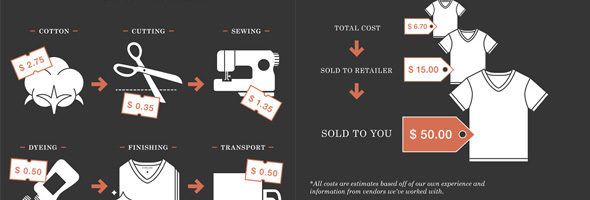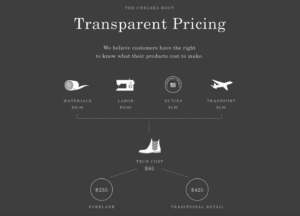Would you pay for the environmental impact of your jeans?

Consider the environmental impact of a pair of jeans. “[Each pair] is made from cotton picked from farms all over the world. The cotton is shipped back and forth across the oceans to be made into fabric, sewn, and dyed. Along the way, the average pair of jeans is treated with PFCs, chemicals that make material breathable and stain-resistant, and washed with detergents that contain alkylphenol ethoxylates, another hazardous compound. The whole process is incredibly water-intensive, from the farm up, and the carbon load from the shipping of the cotton to mills and the raw denim to factories is astronomical on its own. Then there’s the additional impact of the transport, by boat or train or jet, of jeans to stores. They arrive sealed in clear plastic bags, which are promptly trashed, [ending up in landfills].”1 Now ask yourself, do you as a consumer have enough data to evaluate the water consumed to make each pair of jeans? Do you know the amount of toxic chemicals used? Do you know the cumulative carbon load? Unfortunately, no. We as consumers have historically been shielded from the inner workings of the fashion industry. But as topics such as fair labor practices and sustainable sourcing gain momentum, consumers are beginning to demand transparency. A company called Everlane is riding this trend.
Everlane is an emerging start-up disrupting the fashion industry by being “radically transparent.” The company wants to share with its customers details for each item of clothing including what factories a piece was made in and its various cost components (including Everlane’s markup). Given Everlane’s value proposition for being high quality at a lower price than traditional fashion brands, it is laser-focused on costs. It believes that “when it can see the real costs, it can figure out how to lower them.”2 In terms of sustainability, Everlane appears to start and end with ethical manufacturing processes, ignoring environmental impact all together. “Everlane recently hired an auditor to inspect its factories, focusing on safety and health requirements, as well as workers’ wages and quality of life.”2

A sample cost breakdown for The Chelsea Boot provided on Everlane’s website3
Why will Everlane be important? I believe the implementation of global regulations aimed at forcing industries to begin internalizing the costs of environmental damage will have a significant impact on the fashion industry. Excluding the impact of regulations, the industry is also subject to significant input price fluctuations, such as cotton prices from increased incidences of severe draught, water prices as the world shifts towards conservation and transportation costs tied to the rising price of oil. Beginning to focus on these input costs now is simply just good business. As the shift towards transparency continues, Everlane is best positioned to win as the company that started providing its customers the information they wanted before they demanded it.
As quoted above, when you see real costs you can begin figuring out how to lower them. By internalizing costs related to environmental impacts and passing them on to consumers in a way they can understand and quantify, consumers now have the power to make their own decisions about the impact they personally want to have on the environment and can essentially vote with their purchasing power. Companies such as Everlane would also begin tracking these internalized costs and would be keenly focused on developing innovative ways to minimize costs and overall exposure to input price volatility. The companies that excel in minimizing internalized costs have the potential to gain the most market share by providing more affordable clothing while also attracting the customer base that will make decisions based on their environmental impact from the purchase. All parties within the supply chain will now be aligned on minimizing the environmental impact of production. (628 words)
1 http://www.vogue.com/13268385/fashion-supply-chain-environmental-impact/
2 http://www.bloomberg.com/features/2015-everlane-ethical-fashion/
3 https://www.everlane.com/collections/womens-bestsellersv2/products/womens-chelsea-boot-black



A great article which focuses on an everyday item which we often may not think about having a negative impact on our planet. I think the idea of internalising costs is extremely valuable and believe that the practices being perfected by Everlane would be applicable to many companies across almost all industries. To me, the key challenge is helping consumers not to get swamped in receiving too much information and therefore not being able to distinguish between companies which are having and impact and those which are not.
A very enlightening post! I agree that it is important to understand that this isn’t just done for the sake of the environment – it ultimately comes down to protecting the future margins of the business. The question for me becomes how do you make consumers care? Is sustainability part of your consumer-facing value proposition or just part of internal business operations? Is it that by offering a transparent and in some cases, lower prices, consumers who don’t care about sustainability are somehow converted to the brand? I think figuring out how transparent pricing and sustainability fit into the brand message is critical to adoption.
Claire – Wow! I’m now re-evaluating every item in my closet. Your post does a fantastic job explaining why defining all costs is critical to the success and improvement of Everlane’s business going forward. However, there is an additional environmental framework I believe is worth exploring for companies like Everlane. Beyond direct costs, sustainability is reliant on quality and useful life a product; total greater sustainability can be achieved if consumption and therefore, production of items like jeans is reduced. How do manufacturing companies like Everlane incorporate this trade-off into their business model?
Great post Claire! I had head about Everlane before and I think their mission and business strategy is refreshing and potentially disruptive. I would love to see other companies follow suit. This reminds me of when restaurants show the caloric intake of a particular menu item, once you put it there in flashing lights some people are dissuaded from ordering a 2000 calorie item.
On another note, I don’t know however how you make this particular business strategy of internalizing the costs of negative externalities and passing them to your customer, a mass market idea. For now Everlane seems too niche, too expensive, and the people who buy here are already considering labor practices and negative environmental impacts into their purchase decisions (preaching to the choir much?).
Hi Claire – great post! I recently received an Everlane catalog in the mail and noticed in large print on the back of the catalog it said “This catalog cost $0.63 to ship to you” in smaller letters below it noted that the company valued radical transparency and you could learn more at their website. I normally toss catalogs as soon as I receive them (often before I even leave the mail room), but was struck by the oddity of listing the price of the catalog on it and was interested enough to pull up their website (exactly their goal!). I think Everyone’s transparency is working – the question is is it a gimmick or a real opportunity to improve the supply chain for fast fashion?
Very fascinating article Claire! You inspired me to spend the last 20 mins on Everlane’s website. Incredible to see consumers reacting positively to seeing all of the input costs (which are usually 30-40% of market price) and then being MORE inspired to purchase the product.
On your point of water & chemical usage: Do you think it would be better to have all of the details listed (i.e. gallons of water used) or simply to have an ‘eco-badge’ that is 3rd party certified? I would be curious to see the physical numbers but would actually have no clue if 400 gallons of water was high or low for a pair of pants…
Claire, thanks for sharing this with us! As someone keenly aware of the environmental costs and impacts caused by the apparel industry, I find it interesting how Everlane takes lots of strides to be “radically” transparent most parts of the supply chain but does not share the “input” or environmental costs associated with making their clothes. In line with Michaels comment, I wonder how Everlane could share that message to their consumers and engage consumers in the conversation around responsible sourcing.
Very interesting post and I’m most impressed by Everlane’s transparent pricing. This transparent pricing also gives Everlane an opportunity to tack on if it wanted to additional “climate change support” fees whereby it would add a couple dollars to each product cost and pass those fees directly onto NGO’s that are working to combat climate change. I do agree that this transparent pricing is Everlane’s edge and is a great motivator for them to reduce their costs as their consumers can see it.
What I’m interested in is what Everlane is doing in terms of sustainable sourcing. While they may be auditing their suppliers it would be nice to see along with their transparent pricing, a sort of supplier scorecard for each product. The Higg Index was created by a coalition fashion, manufacturing, and retailing companies and measures the sustainability of a product/company. [1] Showing a score like this for each product would just like the transparent pricing, motivate Everlane to push for more sustainable suppliers.
[1] – http://apparelcoalition.org/the-higg-index/
Claire – very interesting company overview. I wonder where else this quantification of environmental impacts could be a source of competitive differentiation. Along those lines, I wonder how sustainable this strategy is. If Everlane is really onto something, I imagine that their competition will follow suit, as there doesn’t seem to be substantial barriers to measuring this impact. Over time, if this becomes relevant to consumers and the government, do you foresee regulation that mandates such disclosure (similar to various jurisdictions requiring the posting of calories content at restaurants)? If that were to happen, I imagine that Everlane’s single source of differentiation would erode, causing this start-up to fade away (the way jeans do as they’re washed repeatedly).
Claire – Your post was very insightful and thought-provoking. Everlane’s approach has clearly established themselves a differentiated in the fashion industry and set themselves up to serve as a leader in the cost transparency movement. I like the idea of visualizing costs and taking responsibility for them as a consumer – a novel concept.
Perhaps in addition to cost transparency – the company could research initiatives at the conclusion of the use of clothing such as buy backs – recycling – donation – in order to extend the life use of a piece of clothing. However, such initiatives must be approached delicately in an industry where brand and image are crucial.
Fantastic article Claire, I never heard of Everlane before and I am definitely interested in knowing more about it now.
As I was reading the article I was thinking about the marketing implication of such a radical shift in the clothing industry. A company like TOMS has been extremely successful in capturing their value proposition and delivering a message that was received by their customers. TOMS was able to turn its social effort into revenue. What do you think are the key of TOMS success and do could Everlane achieve the same? Going back to the title of your article, what would be the market size of the ones who are willing to pay for the environmental impact of their jeans? And what would be your marketing strategy to increase the market size and customer awareness of your brand? Another concern I have is about customer in the clothing industry react to low price, would it be perceived as low quality?